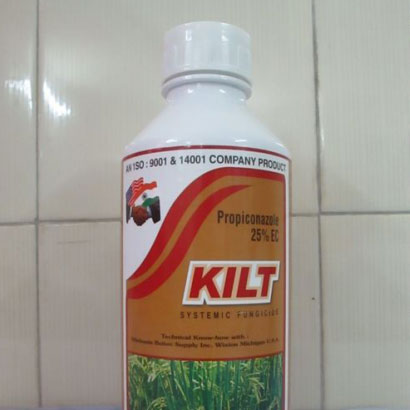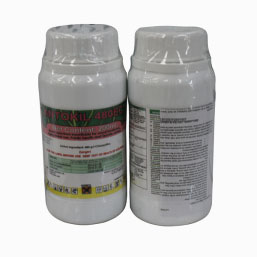Propiconazole 250g/L EC
Applications:
Mode of action Systemic foliar fungicide with protective and curative action, with translocation acropetally in the xylem. Uses Systemic foliar fungicide with a broad range of activity, at 100-150 g/ha. On cereals, it controls diseases caused by Cochliobolus sativus, Erysiphe graminis,Leptosphaeria nodorum, Puccinia spp., Pyrenophora teres,Pyrenophora tritici-repentis, Rhynchosporium secalis, and Septoriaspp. In bananas, control of Mycosphaerella musicola andMycosphaerella fijiensis var. difformis. Other uses are in turf againstSclerotinia homoeocarpa, Rhizoctonia solani, Puccinia spp. andErysiphe graminis; in rice against Rhizoctonia solani,Helminthosporium oryzae, and dirty panicle complex; in coffee againstHemileia vastatrix; in peanuts against Cercospora spp.; in stone fruit against Monilinia spp., Podosphaera spp., Sphaerotheca spp. andTranzschelia spp.; in maize against Helminthosporium spp.
Toxicology:
Oral Acute oral LD50 for rats 1517, mice 1490 mg/kg.
Skin and eye Acute percutaneous LD50 for rats >4000, rabbits >6000 mg/kg. Non-irritating to skin and eyes (rabbits). Skin sensitiser (guinea pigs).
Inhalation LC50 (4 h) for rats >5800 mg/m3.
NOEL (2 y) for rats 3.6, mice 10 mg/kg b.w. daily; (1 y) for dogs 1.9 mg/kg b.w. daily.
ADI (JMPR) 0.04 mg/kg b.w. [1987]; (Syngenta) 0.02 mg/kg b.w.
Other Not mutagenic, not teratogenic. No carcinogenic potential of relevance for human exposure.
Toxicity class WHO (a.i.) II.








